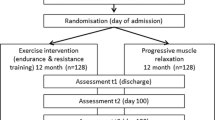Abstract
Patients undergoing intensive chemotherapy for acute leukaemia or aggressive lymphoma not only suffer from the direct side effects of chemotherapy such as infections due to long-lasting immuno-suppression and aplasia, but also from marked fatigue and the inability to do normal physical activity. Furthermore, especially in patients with severe thrombocytopenia, anaemia and leukopenia, doctors recommend abstaining from physical exercise due to the risk of potential bleeding and tissue damage. The normally recommended cutoff level to perform exercise is 50,000 platelets per microliter or haemoglobin of 8 g/dl. This leads to a vicious cycle of loosing physical strength and muscles with subsequent development of treatment-related cachexia and an increased treatment mortality. As number of publications focus on the importance of physical exercise in patients with solid tumours, increasing evidence is found that suggests positive effects on major clinical endpoints such as rate of infection, quality of life and even relapse rate and overall survival. With this work, we intended to address whether intense supervised ergometer training is feasible in patients with severe pancytopenia and whether it has any effect on patients undergoing high-dose chemotherapy. Furthermore, this study was initiated as the groundwork for a large phase III randomised trial.


Similar content being viewed by others
References
Broers S, Kaptein AA, Le Cessie S, Fibbe W, Hengeveld MW. Psychological functioning and quality of life following bone marrow transplantation: a 3-year follow-up study. J. Psychosom. Res. 2000;48:11–21.
Fife BL, Huster GA, Cornetta KG, Kennedy VN, Akard LP, Broun ER. Longitudinal study of adaptation to the stress of bone marrow transplantation. J. Clin. Oncol. 2000;18:1539–49.
McQuellon RP, Russell GB, Rambo TD, Craven BL, Radford J, Perry JJ, et al. Quality of life and psychological distress of bone marrow transplant recipients: the ‘time trajectory’ to recovery over the first year. Bone Marrow Transplant. 1998;21:477–86.
Zittoun R, Achard S, Ruszniewski M. Assessment of quality of life during intensive chemotherapy or bone marrow transplantation. Psychooncology. 1999;8:64–73.
Schule K. The rank value of sports and movement therapy in patients with breast or pelvic cancer. Rehabilitation (Stuttg). 1983;22:36–9.
Dimeo F, Bertz H, Finke J, Fetscher S, Mertelsmann R, Keul J. An aerobic exercise program for patients with haematological malignancies after bone marrow transplantation. Bone Marrow Transplant. 1996;18:1157–60.
Mock V, Burke MB, Sheehan P, Creaton EM, Winningham ML, McKenney-Tedder S, et al. A nursing rehabilitation program for women with breast cancer receiving adjuvant chemotherapy. Oncol. Nurs. Forum. 1994;21:899–907. (discussion 908).
Peters C, Lotzerich H, Niemeier B, Schule K, Uhlenbruck G. Influence of a moderate exercise training on natural killer cytotoxicity and personality traits in cancer patients. Anticancer Res. 1994;14:1033–6.
Andrykowski MA, Henslee PJ, Barnett RL. Longitudinal assessment of psychosocial functioning of adult survivors of allogeneic bone marrow transplantation. Bone Marrow Transplant. 1989;4:505–9.
Winningham ML, MacVicar MG, Burke CA. Exercise for cancer patients. Guidelines and precautions. Physician Sportmed. 1986;14:125–34.
Dimeo F, Fetscher S, Lange W, Mertelsmann R, Keul J. Effects of aerobic exercise on the physical performance and incidence of treatment-related complications after high-dose chemotherapy. Blood. 1997;90:3390–4.
WHO. Exercise tests in relation to cardiovascular function. Technicreports 1968; 338.
Trappe HJ, Lollgen H. Guidelines for ergometry. German Society of Cardiology-Heart and Cardiovascular Research. Z. Kardiol. 2000;89:821–31.
Thiel E, DiMeo F, Böning D. Physical activity in the rehabilitation of oncology patients. the role of aerobic exercise. Dtsch Ärzteblatt. 1999;96:A-1340.
McNeely ML, Campbell KL, Rowe BH, Klassen TP, Mackey JR, Courneya KS. Effects of exercise on breast cancer patients and survivors: a systematic review and meta-analysis. CMAJ. 2006;175:34–41.
Meyerhardt JA, Giovannucci EL, Holmes MD, Chan AT, Chan JA, Colditz GA, et al. Physical activity and survival after colorectal cancer diagnosis. J. Clin. Oncol. 2006;24:3527–34.
Meyerhardt JA, Heseltine D, Niedzwiecki D, Hollis D, Saltz LB, Mayer RJ, et al. Impact of physical activity on cancer recurrence and survival in patients with stage III colon cancer: findings from CALGB 89803. J. Clin. Oncol. 2006;24:3535–41.
Holmes MD, Chen WY, Feskanich D, Kroenke CH, Colditz GA. Physical activity and survival after breast cancer diagnosis. JAMA. 2005;293:2479–86.
Demark-Wahnefried W. Cancer survival: time to get moving? Data accumulate suggesting a link between physical activity and cancer survival. J. Clin. Oncol. 2006;24:3517–8.
Dimeo F, Schwartz S, Fietz T, Wanjura T, Boning D, Thiel E. Effects of endurance training on the physical performance of patients with hematological malignancies during chemotherapy. Support. Care Cancer. 2003;11:623–8.
Baumann FT, Schüle K, Kraut L, Fauser AA. Effects of exercising during the whole phase of stem cell transplantation. Dtsch Z Onkol. 2005;37:152–8.
Baumann FT, Schüle K. Influence of a specific aerobic endurance training program on mental and psychosocial moods in patients with a bone marrow/stem cell transplantation: 3 case studies. Eur Bull Adapt Phys Activity. 2006;5:1–7.
Rogge H. Sport in oncological patients. Physiotherapie (German). 1989;80:540–2.
Mello M, Tanaka C, Dulley FL. Effects of an exercise program on muscle performance in patients undergoing allogeneic bone marrow transplantation. Bone Marrow Transplant. 2003;32:723–8.
Callow CR, Swindell R, Randall W, Chopra R. The frequency of bleeding complications in patients with haematological malignancy following the introduction of a stringent prophylactic platelet transfusion policy. Br. J. Haematol. 2002;118:677–82.
Dimeo F, Knauf W, Geilhaupt D, Boning D. Endurance exercise and the production of growth hormone and haematopoietic factors in patients with anaemia. Br. J. Sports Med. 2004;38:e37.
Author information
Authors and Affiliations
Corresponding author
About this article
Cite this article
Elter, T., Stipanov, M., Heuser, E. et al. Is physical exercise possible in patients with critical cytopenia undergoing intensive chemotherapy for acute leukaemia or aggressive lymphoma?. Int J Hematol 90, 199–204 (2009). https://doi.org/10.1007/s12185-009-0376-4
Received:
Revised:
Accepted:
Published:
Issue Date:
DOI: https://doi.org/10.1007/s12185-009-0376-4




